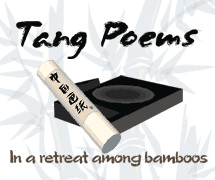This is the lesson attached to the Chinese learning game Tang Poems 1. There are 3 games in the series, totalling 150 essential Chinese characters included in the HSK Beginning Mandarin! Play the FREE version of the game or join us and get the full version!
HSK Beginning Level is the first level of the CLASSIC HSK exams. If you would rather learn the vocabulary for the NEW HSK exams, play the Song Poems game series. Learn more on the HSK exams.
Characters, not grammar rules, are the buiding blocks of the language. Always remember that Chinese is a very old language and that its structures have been set in stone (literally) well before English appeared as a language. Consequently, Chinese sentences evolved more in an organic way than along grammatical rules. Working with characters, not rules, was and is the way in Chinese.
Like hieroglyphs, characters have an aura that make them almost sacred to the Chinese people. Characters cannot be manipulated or changed. They are therefore invariable. Interestingly, this is exactly why so many people resent the simplified form of the Chinese characters.
A notable exception is to be found in Cantonese where a strong sense of humor allows for some variations in the characters.
Exception to not have is a variation from to have.
It may appear that some characters have variations such as he and she, but it is really only an illusion. Each character is composed of their own set of radicals.
Notice that the radical for FEMALE is : we find this radical not only in but also in you (female)
Example 你好 can be written 妳好
Since characters are invariable, only two methods are possible to build up complex sentences: patterns and suffixation.
The pattern method is used to arrange the characters in a pre-determined order. Although the grammatical terms of the Western languages could be translated in Chinese, it is more useful to think of Chinese grammar in terms of patterns.
Example zhǐyǒu… cái… is a pattern for conditional sentences
Suffixation happens when a character is used as a suffix to another character or to a sentence.
Suffixation is a feature particular to Chinese and is used to express many different situations. For example, tenses have to be signaled by adding certain characters to the verb. This is suffixation.


Because Chinese words are invariable, it means that even if the word is plural, the character itself will stay the same.
However it is possible to add a plural mark with the suffixation of , used to form the plural of pronouns and for some specific words involving people such as 同学 tóngxué classmate.
Example 同学们, 你们好 ! Tóngxuémen, nǐmen hǎo! Hello, classmates!
not is the negative for all verbs except for to have, which takes as its negative.
subject 不 verb …
subject 没有 …
Example 我不明白 wǒ bù míngbái I don't understand
Exception 我没有水 wǒ méiyǒu shuǐ I have no water.
A language based on characters has nothing in common with a language based on an alphabet. Of the many consequences there are to this, one of them is for you to adapt your learning processes.
When learning a language, it is often natural that one should learn how to write and how to speak the language at the same time. In Chinese, writing and speaking are intellectually separate processes. As Egyptologists do not need to know how words used to be pronounced to decipher the hieroglyphs, you do not necessarily need to know how to pronounce Chinese words to read and understand Chinese.
This being said, we do recommend you learn both, but not at the same time and not at the same pace. Pinyin is the one tool that allows you to dissociate both processes by bridging the gap.
For example, knowing that thank you is xiè xiè in Chinese should be learned as soon as possible. But the complex strokes involved in writing the characters for thank you (谢谢) should be learned later.
Because grammar is rather simple in Chinese, memorizing the characters and learning the vocabulary are really your two greatest challenges in learning Chinese.
HSK stands for Hanyu Shuiping Kaoshi, which literally means Chinese Level Exam. It is the equivalent of the TOEFL for Mandarin. The HSK certificate is valid for two years.
The HSK test started in 1984 as a Chinese proficiency test for foreigners and Chinese citizens for whom mandarin was a second language. It began to be used in the mid-1990s as part of the admissions process for applications to Chinese universities.
A new HSK test appeared around 2005 alongside the classic one. The new HSK test consists of 6 levels of proficiency. The classic version of the HSK test has 4 categories (Beginning, Elementary, Intermediate and Advanced). This situation lasted until 2010, when it was decided that only the new version would be recognized. However, the classic HSK continues to operate as an advanced proficiency test. In contrast, the new HSK test aims to appeal to students with minimal mandarin proficiency. The first level of the classic exam (Beginning) corresponds to about level 4 on the new HSK exam, while the remaining new levels correspond roughly to the classic Intermediate level.
The new HSK test is made up of listening comprehension and reading comprehension sections, and contains a total of 40 items to be answered within 40 minutes. Students must score at least 120 points to pass the exam. Students who successfully pass the HSK Level I can understand 150 commonly used words and basic grammar patterns, use very simple Chinese sentences, and meet basic needs for communication. The HSK Level 1 is intended for students who have studied Chinese for a semester with 2 to 3 class hours each week.
